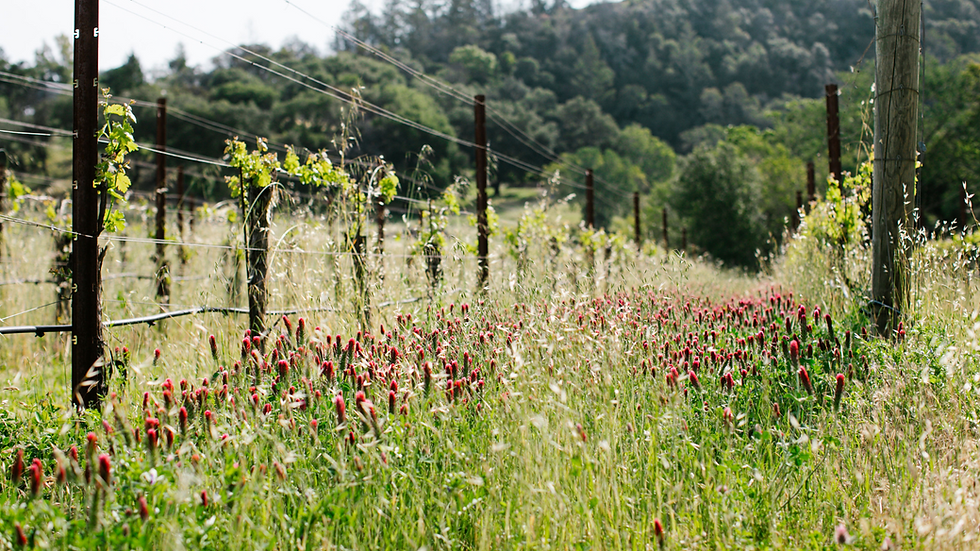A regenerative viticulture primer: How does the way you farm impact your relationship with carbon?
- Regenerative Viticulture Foundation

- 3 mar 2024
- 3 Min. de lectura

This article was guest authored by Becky Sykes, Programme Director at the Regenerative Viticulture Foundation (RVF) — one of IWCA's partners. The RVF is a non-profit organisation dedicated to restoring soil health in the world’s vineyards, reintroducing biodiversity, and sequestering carbon.
A restorative rather than extractive way to farm
In the face of climate change, with extreme summer temperatures and cycles of drought and extreme rainfall events, there is increasing awareness that continuing current practices is not a sustainable way to farm. Instead, a change of approach is required — one which looks at rebuilding the whole ecosystem of the farm as the best way to build resilience to climate change.
A few years ago, regenerative agriculture was seen as a bit leftfield, a risky experiment. But now, just as we realise that our own gut microbiome has a huge influence on our health, so we understand that the soil microbiome has a huge influence on the health of our vines.
The environmental benefits of regenerative viticulture
Living plants growing between the vines year-round act as mini solar panels, providing energy to the microorganisms in the soil, in exchange for nutrients delivered to the vine roots in plant available form. Minimising tillage obviously keeps these roots in the soil and avoids chopping up the fungal networks transporting all these nutrients around. This is expertly explained by Marc-André Selosse in this talk.
To try to eliminate synthetic fertilisers, nutrients removed at harvest and pruning can be replaced by compost, soil amendments, and manure from grazing animals. Some growers even use composted grape pomace and biochar made using vine prunings. Of course, it is essential to monitor soil and vine health.
These same living plants also lower the temperature of the soil in heatwaves, protecting the soil life. Plants with different rooting depths improve soil structure, reducing compaction and increasing water capacity in the soil. This reduces soil erosion due to run off. This is one part of ‘regenerative hydrology’, a new phrase used for adapting the vineyard so that it both increases evapotranspiration and slows down and captures the water when it falls, ready for when it’s needed later. This is beautifully explained by Simon Ricard of Permalab in an interview with Vitisphere here.
Many people are experimenting with planting trees amongst their vines to benefit from shade, reduced air temperatures, increased water holding capacity, and increased biodiversity. Dedicating more of the land to biodiversity projects brings beneficial insects, bats and birds that predate on pests and can help eliminate insecticides.

What about soil carbon sequestration?
There is lots of discussion about increasing carbon stored in the soil. It’s too complex to do it justice in a short blog post but here goes... In essence, some carbon gets stored long-term and some is in a kind of short-term flux that can be returned to the atmosphere through practices like tillage. It’s difficult to measure and there isn’t a standard way to do so. A hot-off-the-press review of 345 studies found that regen practices increase sequestration and that combining these practices may further enhance it. Watch this space…
Learn More

The RVF website has may of resources on soil health, reintroducing biodiversity, and sequestering carbon in vineyards. We also have a glossary, with accompanying explanations and examples, of key regenerative viticulture concepts here.






Sí, avia master muestra historial de partidas, lo que me resulta muy útil jugando en Brazino777 México. Esto permite revisar patrones, entender cómo se comportan los multiplicadores y ajustar estrategias sin arriesgar demasiado. La información se presenta de manera clara y accesible, ayudando tanto a principiantes como a jugadores experimentados a tomar decisiones más informadas y mejorar su rendimiento en cada sesión.
Thanks to this site I was finally able to lose weight! I am very happy to have found this site - https://valhallavitality.com/blog/exploring-retatrutide-a-breakthrough-in-weight-loss-solutions - because now I weigh much less and look much better. You should try this site too, because it has a lot of cool tips.